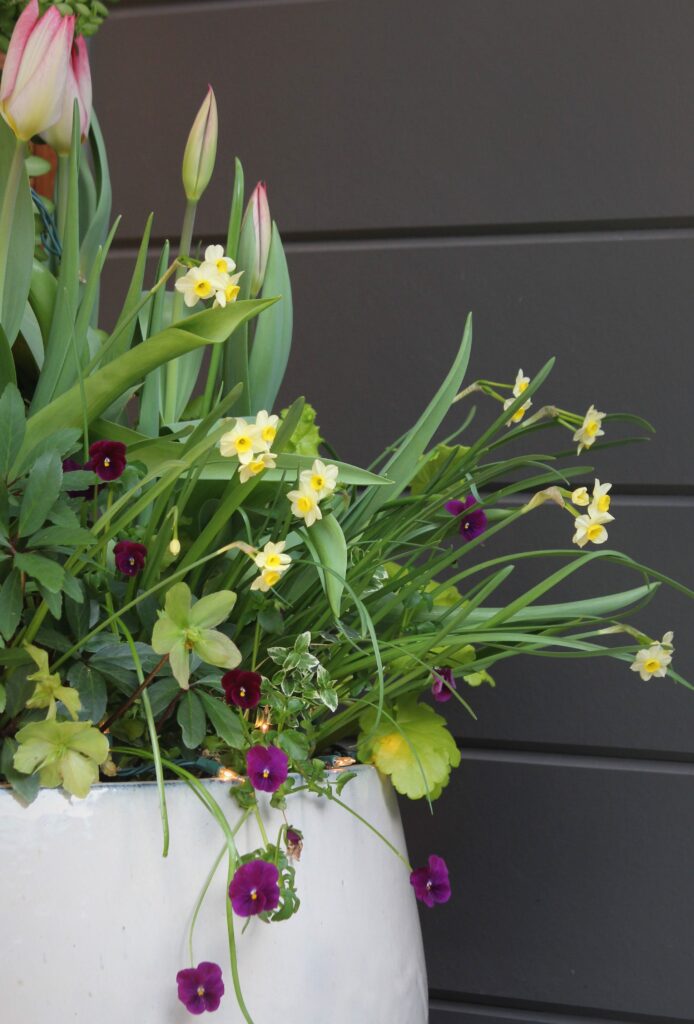
March Makeover: Tips for Refreshing Your Spring Containers
CONTAINED
BRILLIANCE
March can be such a tease, luring us with its transition from winter to spring and often bringing about unpredictable weather changes. It can be a mix of warm spells and sudden cold snaps. During this period, our container plantings might start looking a bit dreary. So how do you transition your container plantings during this shambolic time when many of our plantings have a "sad sack" look about them? The answer lies in a spring refresh!
Living in Seattle, Zone 8b, it’s rare that I change out an entire planting this time of year. Rather than starting from scratch, I have learned that with careful plant selection, some assessment, and by embracing a few simple design concepts, a complete overhaul isn’t necessary.
Plant Selection
I opt for a strategic refresh by blending annuals, perennials, and evergreens when planting a container. This helps plantings to endure the seasonal shift. Evergreens, if well maintained, can remain in a container for multiple seasons. Additionally, they help serve as a distraction from the perennial that has yet to emerge. Annuals are a minimum investment and can be swapped out easily if failing to thrive or as a way to explore seasonal colors and themes.
- Evergreen - Keeps its leaves on all year increasing in size over time. It can be the centerpiece in the planting. Evergreens are more cost effective being long lasting.
- Perennial – Goes dormant for a season and then remerges increasing in size each season. They need deadheading, staking and dividing.
- Annual – Seasonals lasting 4-6 months on average and serve as eye candy.
The Selective Refresh
Selectively refresh your plantings by replacing struggling or weather-beaten plants with fresh additions. Begin by assessing your broadleaf or needled evergreen. It is likely the centerpiece of your planting and can serve as a steadfast focal point amidst the changing seasons. The next step is to evaluate your perennials and annuals. Remove any dead or struggling plants and clip damaged or diseased leaves. After that, cool season annuals and spring blooming bulbs can be planted to replace any plants removed or space created by the primping of foliage to provide a fresh theme and/or new pop of color until summer's plants arrive on the scene.
Embrace Design Concepts
One of the fantastic things about container gardening is that you can take the simplest and most mundane of plants and combine them in a way that creates an interesting if not show-stopping composition through design. Understanding and implementing just a few container design concepts will support your success by helping to inform your plant choices and planting.

- Form - Some call it "thriller, filler, spiller", others "vertical, mounding, trailing", or "highlight, spotlight, limelight"; whatever you call it, it’s a basic container gardening concept. It is the idea of creating a planting combination that has height, depth, and structure. This basic recipe’s success comes from creating impact and depth by layers, thus moving the eye through the planting to create interest.
- Color - Echo what is happening naturally in the early spring landscape to create new themes and copy the mood, brightness and energy of the emerging season. Because, color can be so personal, much like art, wine or food, we all experience color a bit differently. Select colors and combinations that you love and find appealing. Noting colors that you like and how they make you feel is a fun indulgence. Modify your color palette to reflect your preferences, introducing the lively yellows and other shades synonymous with spring. Likewise, consider blending cool weather annuals such as pansies, primroses, and violas with early spring blooms of grape hyacinths, tulips and daffodils to conduct a delightful symphony of spring color.
- Texture - Similar to fabric, texture is the visual and tactile surface of the leaves and flowers of a plant. It holds significance as these diverse surfaces and shapes reflect light differently creating patterns and depth. Texture provides subtler nuances and interest compared to color, enriching the overall visual experience. Enhancing your planting's texture with foliage involves weaving together a tapestry of varied shapes, encompassing both large and small-leaved plants with glossy and matte surfaces. This approach will yield you the most captivating and cost-effective results. Unlike flowers, foliage doesn't require deadheading and typically endures far longer.
- Repetition - Create a rhythm of lines both horizontal and vertical by repeating colors, shapes, and textures. This is pleasing to the eye and makes for a cohesive planting.
In conclusion, embrace March as an occasion for renewal – an opportunity to change things up a bit like we do in other aspects of our lives when the seasons change. Ultimately, container gardening should not be intimidating. It’s akin to an art form – an intentional fusion of plants that brings beauty and joy to your outdoor living spaces.
So, seize the moment, roll up your sleeves and breathe new life into your spring containers on the next sunny day.



